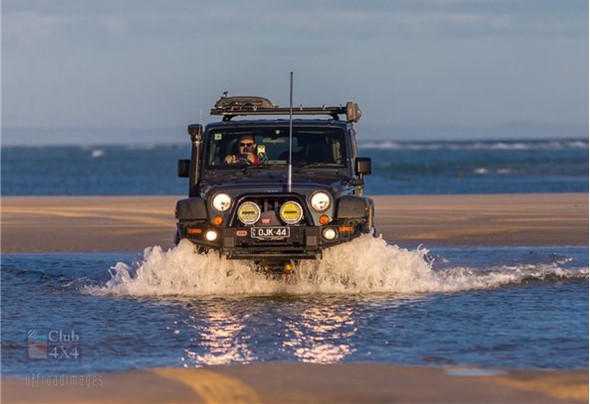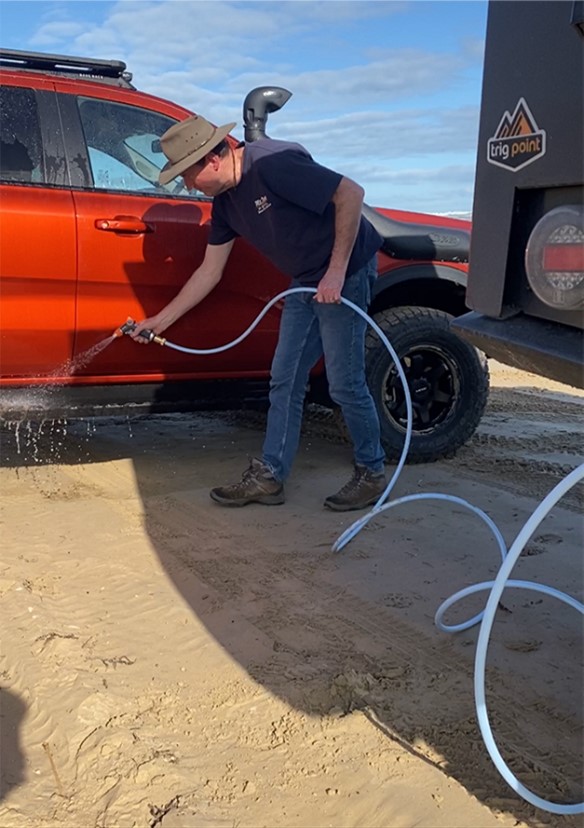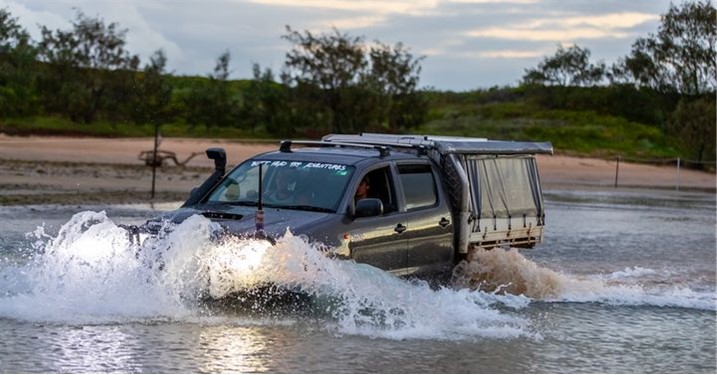This article was first published in Club 4X4’s, The Campfire, February 2024 – Michael Ellem, 15 February 2024
When you think of beach driving in your 4WD, many people fear the potential of rusting their vehicle. Whether you have an old, worn-out 4WD or the latest brand-new model, the idea of taking it off-road on a beach often conjures thoughts of rust and corrosion.

The thought of your 4WD rusting simply because you took it to the beach can be quite daunting for many. For some, it might generate enough of a negative feeling to dissuade them from participating in beach driving altogether. Others may opt to drive on the sand cautiously, making sure not to venture too close to the water’s edge.
There are people who feel that driving in saltwater poses no real problem, and they simply splash about with no concern in the world.

Which one are you?
I am writing this after listening to a conversation during our last photoshoot, where people discussed their concerns after one of the vehicles clipped a small pothole on the beach, splashing saltwater up the side of the vehicle.
I suggested we wash it all away using freshwater from the tanks under our Trigpoint canopy, and in no time, the high pressure pump washed away any evidence that the event had ever happened.

I was trying to explain to people that the salt in the sand further up the beach, combined with the salt mist floating over and through your vehicle, is worse than the saltwater that was driven through.
I think we all agree that saltwater is bad for a 4WD. So, we might assume that you should be alright if you don’t drive in the saltwater.
What do you think?
But what about the sand you drive in? Am I okay to drive on the beach in sand that is not wet from the ocean?
Without sparking a debate, I would like to introduce a lesser-known fact to the discussion.
Did you know that, as a percentage, the salt content found in sand on a beach is comparable to that found in saltwater?
Obviously, different oceans around the world can have varying salt concentrations. A notable example is the Red Sea, where the salt content is so high that you can easily float in it, and if not careful, you could even burn yourself. This is due to factors such as low precipitation, high evaporation, and minimal river run-offs in the confined area. However, in general, the salt content in the seas around the coastlines of Australia ranges from around 3.1 to 3.8.
If you were aware that the salt content in beach sand is a similar percentage to that in saltwater, would you still choose to drive on a beach at all?
Well, the salt content typically found on a beach, within beach sand, usually ranges from 3 to 4% by weight.
This is roughly equivalent to the amount of salt found in the ocean.
You might argue that the salt doesn’t stick to your vehicle, whereas saltwater, after drying, leaves salt residue.

Let’s consider a dune that has been wind-swept in the desert. It would consist of millions of grains of sand blown across the ground, forming ripples in the sand dune. When disturbed, the shape would change extremely easily as the grains are free-flowing.
On a beach, you might be familiar with sand forming in clumps. It still maintains a dry consistency, but the grains of sand may be bound together by salt, much like a binding agent. It could be argued that these areas of sand could contain a higher concentration of salt.
But sand gets everywhere. It infiltrates your chassis rails, vehicle panel joins, carpets, door frames, vehicle trims, and the list goes on. Consider this: all that sand spraying up around your vehicle, settling in the window frames and door seals, infiltrating your vehicle’s engine bay – 3-4% of these items are salt. While a fair amount may bounce off, much of it will stick to your vehicle or work its way into crevices. If left untreated, this salt-laden sand can affect your vehicle in many ways, leading to corrosion or rust developing over time.
What’s worse, if you don’t properly wash your vehicle before heading to the beach, there’s a chance that you already had mud attached to underbody components and mechanical items. This sand being sprayed up is more likely to collect and introduce corrosive activity.

This doesn’t mean that we should all turn our 4WDs into submarines and drive along the coastline, as it really is not a good look for 4WDers at all. But the intention of this article is to put things into perspective and point out that even if you drive onto a beach and don’t go near the water’s edge, you will end up with salt residue on your vehicle.
When you are on the coast, salt is everywhere. It floats in the air, it sits in the sand, and it will attach itself to your vehicle. When you get off the beach, you should take extra care in washing your vehicle, using good products designed to dissolve salt and remove sand.
Article submitted by Trevor Burford